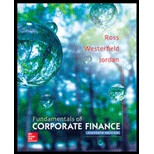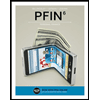
To determine: Whether the policy is worth purchasing.
Introduction:
The
Answer to Problem 70QP
The policy is not worth purchasing.
Explanation of Solution
Given information:
An insurance company offers a new policy to their customers. The children’s parents or grandparents buy the policy at the time of the child’s birth. The parents can make 6 payments to the insurance company. The six payments are as follows:
- On the 1st birthday the payment amount is $700.
- On the 2nd birthday the payment amount is $700.
- On the 3rd birthday the payment amount is $800.
- On the 4th birthday the payment amount is $800.
- On the 5th birthday the payment amount is $900.
- On the 6th birthday the payment amount is $900.
After the 6th birthday of the child, the payment is not made. At the time when the child is 65 years, he or she gets $150,000. The interest rate for the first 6 years is 9% and for the rest of the years is 6%.
Note: From the given information, it is essential to compute the future value of the premiums for the comparisons of the promised cash payments at 65 years. Thus, it is necessary to determine the premiums’ value at 6 years first as the rate of interest varies at that time.
Formula to calculate the future value is as follows:
Note: PV denotes the
Compute the future value for the five years is as follows:
Hence, the future value of the 1st year is $1,077.04.
Hence, the future value of the 2nd year is $988.11.
Hence, the future value of the 3rd year is $1.036.02.
Hence, the future value of the 4th year is $950.48.
Hence, the future value of the 5th year is $981.
Compute the value of the 6th year is as follows:
Note: The value of the 6th year is calculated by adding all the computed future values and the 6th year’s value that is $900.
Hence, the value of the 6th year is $5,932.65.
Compute the future value of the lump sum at the 65th birthday of the child is as follows:
Note: The number of years is 59, as only after the 6th birthday of the child the payments are not paid.
Hence, the future value of the lump sum at the 65th birthday of the child is $184,626.72.
From the above calculation of the future value, it can be stated that the policy is not worth purchasing as the deposit’s value in the future is $184,626.72 but the contract will pay off at $150,000. The premium’s amount to $34,626 is more than the payoff of the policy.
Note: The present value of the two cash flows can be compared.
Formula to calculate the present value of the premiums is as follows:
Compute the present value of the premiums is as follows:
Hence, the present value of the premiums is $3,537.44.
The today’s value of the $150,000 at the age of 65 is as follows:
The cash flow of the premiums is still higher. At the time of zero, the difference is $663.45
Want to see more full solutions like this?
Chapter 6 Solutions
Fundamentals of Corporate Finance
- no ai Image is blurr do not answer this question if data is not clear or image is blurr. please comment i will write values but do not amswer with unclear values. i will give unhelpful sure.arrow_forwardDon't solve this question with unclear data. i will give unhelpful rating . please skip this qnarrow_forwardThe prodave paint company earned a net profit margin of 20% on revenues of $20m this year. Fixed Capital Investment was $2 m and depreciation was $3 m. Working capital Investment equals 7.5% of the Sales level in that year. Net income, fixed Capital Investment, depreciation, interest expenses and sales are expected to grow at 10% per year for the next 5 years. After 5 years, the growth in sales , net income, depreciation and interest expenses will decline to a stable 5% per year and fixed Capital Investment and depreciation will offset each other. The tax rate is 40% and the prodave has 1 m shares of common stock outstanding and long term debt paying 12.5% interest trading at it's par value of $32 m. The WACC is 17% during the high growth stage and 15% during the stable growth stage. Required: a) Calculate FCFE b) Determine FCFF c) Estimate the value of Equity d) Calculate the value of the Firmarrow_forward
- A key dynamic within any Multi-National Corporation (MNC) is cash and foreign exchange risk exposure. Cash management is critical and also heavily influenced by global dynamics, especially since COVID-19. Within the Caribbean and North American jurisdiction, the economic framework is tightly connected with the major Asian economies of China, the United Kingdom and Japan. The Caribbean and the North American economy have been a barometer of the global economic cycle.) For both Caribbean and North American economies, many Multi-National Corporations have made significant investments to reduce the production cost of goods and diversification benefits. Despite the benefits that could materialize, some North American countries have not been resilient through Global market shocks. Given this context, the following questions require research within the Caribbean context and current market dynamics since COVID-19. Your Manager has asked you to address the following concerns in the report 1)…arrow_forwardA key dynamic within any Multi-National Corporation (MNC) is cash and foreign exchange risk exposure. Cash management is critical and also heavily influenced by global dynamics, especially since COVID-19. Within the Caribbean and North American jurisdiction, the economic framework is tightly connected with the major Asian economies of China, the United Kingdom and Japan. The Caribbean and the North American economy have been a barometer of the global economic cycle.) For both Caribbean and North American economies, many Multi-National Corporations have made significant investments to reduce the production cost of goods and diversification benefits. Despite the benefits that could materialize, some North American countries have not been resilient through Global market shocks. Given this context, the following questions require research within the Caribbean context and current market dynamics since COVID-19. Your Manager has asked you to address the following concerns in the report 1)…arrow_forwardA key dynamic within any Multi-National Corporation (MNC) is cash and foreign exchange risk exposure. Cash management is critical and also heavily influenced by global dynamics, especially since COVID-19. Within the Caribbean and North American jurisdiction, the economic framework is tightly connected with the major Asian economies of China, the United Kingdom and Japan. The Caribbean and the North American economy have been a barometer of the global economic cycle.) For both Caribbean and North American economies, many Multi-National Corporations have made significant investments to reduce the production cost of goods and diversification benefits. Despite the benefits that could materialize, some North American countries have not been resilient through Global market shocks. Given this context, the following questions require research within the Caribbean context and current market dynamics since COVID-19. Your Manager has asked you to address the following concerns in the report 1)…arrow_forward
- Jeff Krause purchased 1,000 shares of a speculative stock in January for $1.89 per share. Six months later, he sold them for $9.95 per share. He uses an online broker that charges him $10.00 per trade. What was Jeff's annualized HPR on this investment? Jeff's annualized HPR on this investment is %. (Round to the nearest whole percent.)arrow_forwardCongratulations! Your portfolio returned 16.7% last year, 2.5% better than the market return of 14.2%. Your portfolio had a standard deviation of earnings equal to 18%, and the risk-free rate is equal to 4.4%. Calculate Sharpe's measure for your portfolio. If the market's Sharpe's measure is 0.29, did you do better or worse than the market from a risk/return perspective? The Sharpe's measure of your portfolio is (Round to two decimal places.)arrow_forwardOn January 1, 2020, Simon Love's portfolio of 15 common stocks had a market value of $258,000. At the end of May 2020, Simon sold one of the stocks, which had a beginning-of-year value of $26,900, for $31,400. He did not reinvest those or any other funds in the portfolio during the year. He received total dividends from stocks in his portfolio of $11,900 during the year. On December 31, 2020, Simon's portfolio had a market value of $246,000. Find the HPR on Simon's portfolio during the year ended December 31, 2020. (Measure the amount of withdrawn funds at their beginning-of-year value.) Simon's portfolio HPR during the year ended December 31, 2020, is %. (Round to two decimal places.)arrow_forward
- Chee Chew's portfolio has a beta of 1.27 and earned a return of 13.6% during the year just ended. The risk-free rate is currently 4.6%. The return on the market portfolio during the year just ended was 10.5%. a. Calculate Jensen's measure (Jensen's alpha) for Chee's portfolio for the year just ended. b. Compare the performance of Chee's portfolio found in part a to that of Carri Uhl's portfolio, which has a Jensen's measure of -0.25. Which portfolio performed better? Explain. c. Use your findings in part a to discuss the performance of Chee's portfolio during the period just ended.arrow_forwardDuring the year just ended, Anna Schultz's portfolio, which has a beta of 0.91, earned a return of 8.1%. The risk-free rate is currently 4.1%, and the return on the market portfolio during the year just ended was 9.4%. a. Calculate Treynor's measure for Anna's portfolio for the year just ended. b. Compare the performance of Anna's portfolio found in part a to that of Stacey Quant's portfolio, which has a Treynor's measure of 1.39%. Which portfolio performed better? Explain. c. Calculate Treynor's measure for the market portfolio for the year just ended. d. Use your findings in parts a and c to discuss the performance of Anna's portfolio relative to the market during the year just ended.arrow_forwardNeed answer.arrow_forward
 PFIN (with PFIN Online, 1 term (6 months) Printed...FinanceISBN:9781337117005Author:Randall Billingsley, Lawrence J. Gitman, Michael D. JoehnkPublisher:Cengage Learning
PFIN (with PFIN Online, 1 term (6 months) Printed...FinanceISBN:9781337117005Author:Randall Billingsley, Lawrence J. Gitman, Michael D. JoehnkPublisher:Cengage Learning

